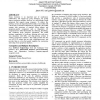WMCSA
1999
IEEE
14 years 4 months ago
1999
IEEE
Current groupware systems do not work well over wireless networks, as a wireless connection is of variable and often poor quality. Our research suggests a number of changes that a...
GROUP
1999
ACM
14 years 4 months ago
1999
ACM
Many object-oriented toolkits and frameworks for groupware development provide shared objects as a basic service. This relieves developers of a lot of problems originating from th...
DSVIS
2000
Springer
14 years 4 months ago
2000
Springer
This paper presents an example of how software architectures can encode temporal properties as well as the traditional structural ones. In the context of expressing concurrency con...
CSCW
2000
ACM
14 years 4 months ago
2000
ACM
A need exists to develop groupware systems that adapt to available resources and support user mobility. This paper presents DACIA, a system that provides mechanisms for building s...
COLCOM
2009
IEEE
14 years 5 months ago
2009
IEEE
—Combining support for single display collaboration with support for asynchronous and remote collaboration in one groupware challenges some basic assumptions of application desig...
GROUP
2003
ACM
14 years 5 months ago
2003
ACM
Group awareness is an important part of synchronous collaboration, and support for group awareness can greatly improve groupware usability. However, it is still difficult to build...
CSCW
2004
ACM
14 years 5 months ago
2004
ACM
The status quo for co-located groupware is to assume that “social protocols” (standards of polite behavior) are sufficient to coordinate the actions of a group of users; howev...
CSCW
2004
ACM
14 years 5 months ago
2004
ACM
Although telepointers are valuable for supporting real-time collaboration, they are rarely seen in commercial groupware applications that run on the Internet. One reason for their...
DSVIS
2005
Springer
14 years 5 months ago
2005
Springer
Abstract. Stochastic model checking is a recent extension of traditional modelchecking techniques for the integrated analysis of both qualitative and quantitative system properties...
ASWEC
2006
IEEE
14 years 6 months ago
2006
IEEE
Implementing support for group awareness is an essential and challenging process in groupware development. This paper reports our research on developing a Transparent Adaptation (...





